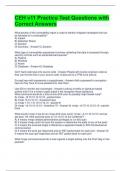Exam (elaborations)
CEH v11 Practice Test Questions with Correct Answers
- Course
- Institution
CEH v11 Practice Test Questions with Correct Answers What section of the vulnerability report is used to identify mitigation strategies that can be followed for a vulnerability? A) Impact B) Detection Result C) Solution D) Summary - Answer-C) Solution What type of vulnerability assessment...
[Show more]



